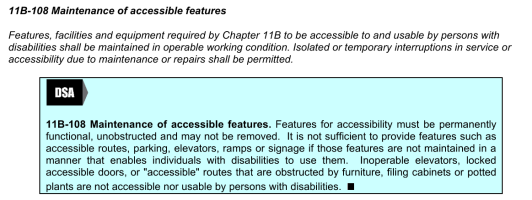arwat23
SAWHORSE
At an existing facility, do I need to provide temporary accessible parking while altering the existing accessible parking?
Example: Let's say the slope of a parking space is too steep. You need to level it out. It'll take two weeks to do the work. The building is still open to the public and business are operating during the alteration. Since there is a reduction in the number of parking spaces while the alteration happens, would that be an issue?
What if the accessible parking count exceeds the minimum count required by code and there's still enough spaces to meet the minimum count during the alteration?
A few weeks an inspector told me they wouldn't allow alterations to some existing non-complaint accessible parking space unless I provided some temporary spaces while the accessible spaces were unavailable. This is the first time I've been told something like that, so I'm curious if I'm missing something in code that would prevent the temporary reduction in accessibility to correct issues.
Example: Let's say the slope of a parking space is too steep. You need to level it out. It'll take two weeks to do the work. The building is still open to the public and business are operating during the alteration. Since there is a reduction in the number of parking spaces while the alteration happens, would that be an issue?
What if the accessible parking count exceeds the minimum count required by code and there's still enough spaces to meet the minimum count during the alteration?
A few weeks an inspector told me they wouldn't allow alterations to some existing non-complaint accessible parking space unless I provided some temporary spaces while the accessible spaces were unavailable. This is the first time I've been told something like that, so I'm curious if I'm missing something in code that would prevent the temporary reduction in accessibility to correct issues.

